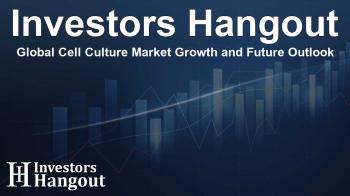Global Cell Culture Market Growth and Future Outlook

Global Cell Culture Market Overview
The cell culture market is experiencing impressive growth, with projections indicating it will reach a staggering USD 93.49 billion by the end of the forecast period. This significant increase represents a compound annual growth rate (CAGR) of 14.23% from 2026 onwards. The surge in demand is driven by several factors, including advancements in drug development, vaccine production, and scientific research focused on stem cells.
Key Market Drivers
One of the primary drivers of growth within the cell culture market is the heightened demand for biopharmaceuticals. As the prevalence of diseases such as cancer and autoimmune disorders rises, so does the need for innovative, biologic therapies. Biopharmaceutical firms rely heavily on sophisticated cell culture systems to develop essential products like monoclonal antibodies and vaccines.
Dependence on Advanced Systems
This dependence on high-quality cell culture products means that precision and scalability are critical factors in the production of biologics. With many companies investing heavily in advanced platforms for mammalian cell culture, the market is witnessing an influx of innovations aimed at improving overall efficiency and effectiveness.
Focus on Regenerative Medicine
Another compelling aspect driving the cell culture market's expansion is its increasing application within the fields of regenerative medicine and stem cell research. Innovative technologies and methodologies, such as 3D cell culture, are being adopted to simulate real-life cellular environments more accurately, which is transformative for clinical trials and personalized medicine.
Emerging Technologies in Cell Culture
Rapid technological advancements are redefining the landscape of cell culture practices, enhancing their efficiency and reliability. Automation and high-throughput systems are being integrated extensively to optimize processes and reduce the need for extensive manual labor.
Innovations Enhancing Cell Culture
Recent innovations in cell culture media, particularly chemically defined and xeno-free options, are boosting cell viability while minimizing variability introduced by animal-derived components. The introduction of perfusion bioreactors, microcarrier-based cultures, and AI-enabled monitoring is further facilitating cutting-edge bioprocessing, enabling companies to streamline their workflows for better productivity.
Challenges Facing the Market
Despite these advancements, the cell culture market faces significant hurdles. High costs associated with cell culture equipment and consumables present a barrier—especially for startups and smaller research facilities. Establishing a fully operational cell culture lab requires substantial investment, and ongoing operational costs can be burdensome.
Geographical Insights
Geographically, North America maintains a prominent position as a leader in the cell culture market, attributed to its robust biopharmaceutical R&D, advanced healthcare infrastructure, and rapid adoption of innovative technologies. The U.S. is recognized as a major hub for biologics manufacturing, with considerable investment flowing into regenerative medicine and stem cell research.
Regional Trends in Cell Culture
Europe, fueled by government initiatives and academic research, follows closely behind North America in market share. Meanwhile, companies within the Asia-Pacific region, particularly in nations like Japan and South Korea, are making noteworthy strides, thanks to their burgeoning clinical trial enrollments and a growing pharmaceutical industry.
Conclusion: Looking Ahead
The future of the cell culture market appears bright, with key players investing in innovative practices that promise to alleviate current challenges. Stakeholders range from pharmaceutical executives and healthcare investors to research professionals and policymakers, each gaining essential insights from market analyses.
This growing market is not just a trend but represents a pivotal shift in medical research and development, ultimately leading to improved patient outcomes and groundbreaking treatments in the world of healthcare.
Frequently Asked Questions
What is the projected growth rate of the Cell Culture Market?
The Cell Culture Market is projected to grow at a CAGR of 14.23% from 2026 to 2032.
What factors are driving the growth of this market?
Key factors include the rising demand for biopharmaceuticals, advancements in regenerative medicine, and continued technological innovations.
Which regions are significant contributors to market growth?
North America remains the dominant region, with notable contributions from Europe and the Asia-Pacific region.
What challenges does the Cell Culture Market face?
High costs for equipment and consumables, as well as contamination risks, pose significant challenges to market expansion.
Who are the key players in the Cell Culture Market?
Major players include Thermo Fisher Scientific, Merck KGaA, Danaher Corporation, Lonza Group, and Corning Incorporated.
About The Author
Contact Riley Hayes privately here. Or send an email with ATTN: Riley Hayes as the subject to contact@investorshangout.com.
About Investors Hangout
Investors Hangout is a leading online stock forum for financial discussion and learning, offering a wide range of free tools and resources. It draws in traders of all levels, who exchange market knowledge, investigate trading tactics, and keep an eye on industry developments in real time. Featuring financial articles, stock message boards, quotes, charts, company profiles, and live news updates. Through cooperative learning and a wealth of informational resources, it helps users from novices creating their first portfolios to experts honing their techniques. Join Investors Hangout today: https://investorshangout.com/
The content of this article is based on factual, publicly available information and does not represent legal, financial, or investment advice. Investors Hangout does not offer financial advice, and the author is not a licensed financial advisor. Consult a qualified advisor before making any financial or investment decisions based on this article. This article should not be considered advice to purchase, sell, or hold any securities or other investments. If any of the material provided here is inaccurate, please contact us for corrections.

